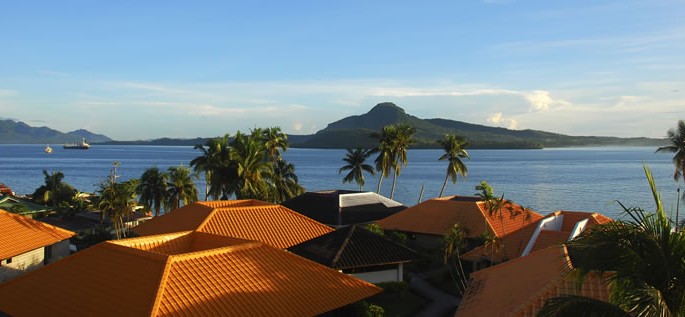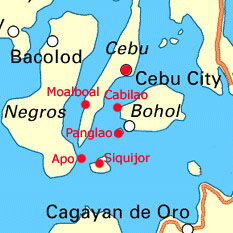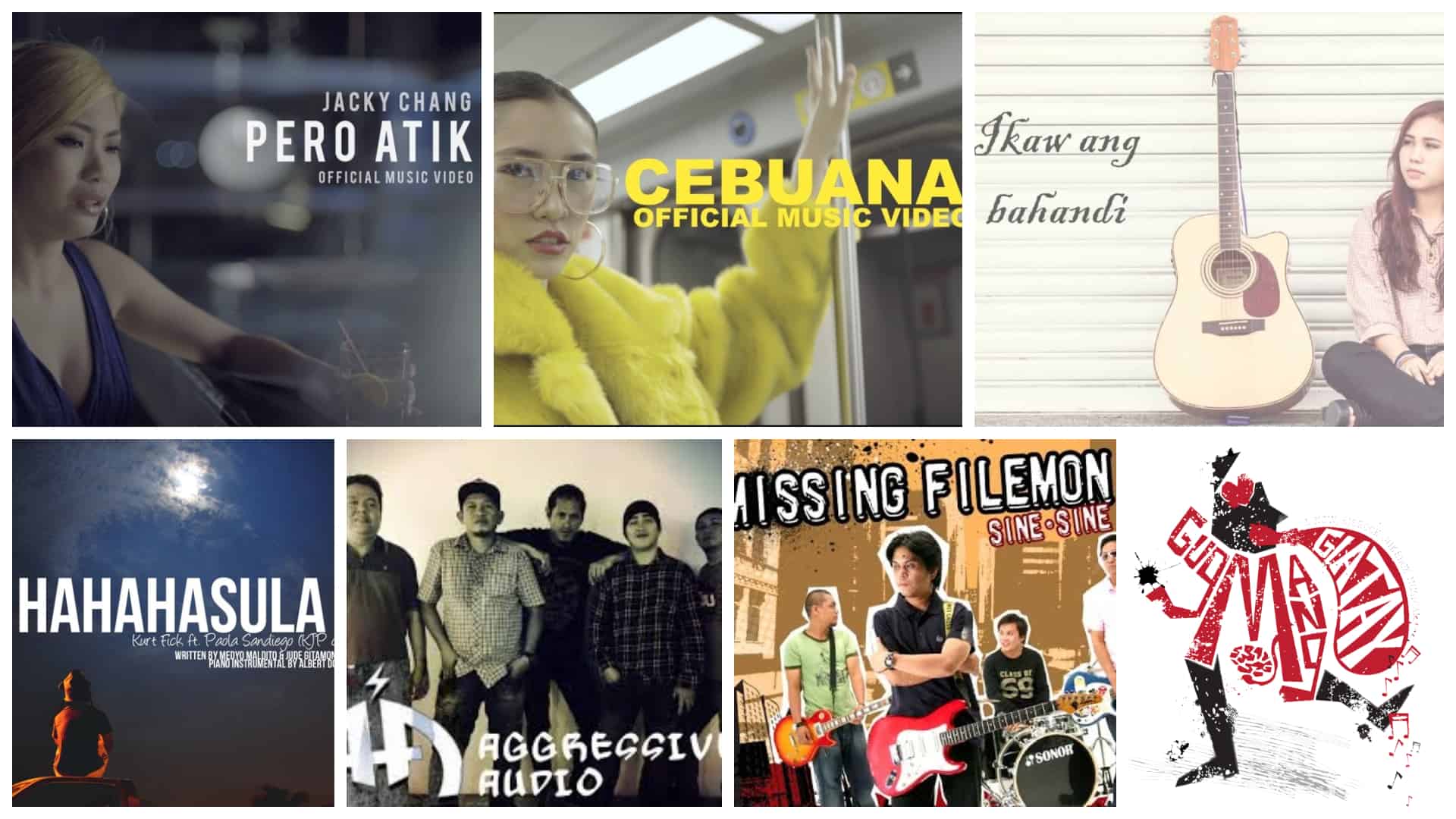by Serafin Colmenares, Jr.
On August 3, 2002, the first set of Lapu-Lapu Awards was given out in Honolulu. Sponsored by the Congress of Visayan Organizations (COVO), the Awards, named after Visayan native chief Lapu-Lapu, recognized the achievements of Filipinos of Visayan origin in Hawaii. As the first native leader who subdued the conquistador Ferdinand Magellan in the Battle of Mactan, Lapu-Lapu is considered the first Filipino hero. The Awards event was an eye-opener and it quickly became a source of pride among Filipinos of Visayan ancestry, who, until then, were relatively unaware of what their fellow Visayans have achieved since they first arrived in Hawaii in the early 1900s.Who are the Visayans?
Visayans (also spelled Bisayans) generally refer to people who trace their roots to the Bisayan-speaking region in central Philippines. This region includes the islands of Panay, Romblon, Guimaras, Negros, Cebu, Bohol, Siquijor, Leyte, Biliran and Samar. However, because of migration over time, a large part of Mindanao (from Zamboanga up to northern Mindanao and down toDavao and Cotabato) is now largely populated by Visayans. Thus, it is not uncommon for people from Mindanao to call themselves “Visayan,” especially if they are native speakers of the Bisaya language.
Bisaya is a group of related languages belonging to the Malayo-Polynesian family. Spoken in the central and southern Philippines, it is comprised of roughly 25 languages, some near extinction with under 1,000 native speakers and others spoken by millions. Bisaya includes Cebuano, Hiligaynon or Ilonggo, Aklanon, Capiznon, Kinaray-a, Bantoanon, Romblomanon, Cuyonon, Waray, Surigaonon, Butuanon, Tausog, etc. Spoken by approximately 28 million people, the Bisaya language family has the largest number of native speakers in the Philippines. The next two are the Tagalogs and Ilokanos.
The origin of the term “Visayan “ is unclear. Some sources say it refers to Shri Vijaya, the ancient island Southeast Asian empire to which the original Visayans supposedly belonged. Others consider the term a literal rendering of the Visayan sadya or the Tagalog saya, meaning happiness. The latter version appears to stem from the stereotype that Visayans are a generally laid-back, fun loving and happy-go-lucky people. But as Visayans themselves would put it, they are a hardworking people who just know how to enjoy life.
Visayans take pride in their role in Philippine history. The islands that were “discovered” by Magellan and later named by Villalobos Felipinas were actually the Visayas. It was here that the natives under Lapu-Lapu repelled the first Western aggression, setting back Spanish colonization by almost 50 years. Christianity was first planted on these islands with the first two Spanish settlements in the Philippines (Cebu and Iloilo). Visayans are also proud of their culture, exemplified by dances of Visayan origin, such as tinikling, itik-itik, and kuratsa; songs like Matud Nila, Sa Kabukiran, Walay Angay, Dandansoy, Ay Ay Kalisud, and Lawiswis Kawayan; festivals honoring the Santo Niño: the Sinulog of Cebu, Ati-Atihan of Aklan, and Dinagyang of Iloilo; and the Visayan martial arts of kali and eskrima. Pride is also seen in the achievements of Sumoroy, Dagohoy, Graciano Lopez Jaena, Carlos Garcia, Sergio Osmeña, and many others.
The Visayan region is uneven in development. The eastern part inhabited by the Warays is the least developed. But Western Negros island is rich in resources and it was here that sugar flourished, making many Negrenses hacenderos (wealthy landlords). Commercial sugar production began in the late 1840s. Since then, migrant workers from the rest of the Visayas – called sacadas (also spelled sakadas) – were recruited by the landlords for the harvests. (The term would be used later to refer to migrant workers in other parts of the Philippines and in the Hawaii plantations.)
Visayans in Hawaii
The first group of Visayan sakadas arrived in Hawaii in 1909, three years after the first group of Filipino contract workers – 15 Ilokanos in 1906 and another 150 in 1907 – were brought in by the Hawaii Sugar Planters Association (HSPA). The HSPA stopped recruiting in 1908, declaring its Philippine recruitment efforts a failure. In 1909, faced with a serious labor shortage due to the Japanese workers’ strike, the HSPA resumed its recruitment in the Philippines. They opened additional recruitment offices in the Visayas region, particularly Cebu, Iloilo and Bohol. This netted 639 recruits (including women and children) in 1909, followed by 2,915 in 1910. Most of the recruits were from the islands of Cebu, Siquijor, Panay, Bohol and Leyte. Among the 1909 group were the first Visayan families who arrived in Hawaii: the Yorong and Magpiong families, whose descendants still live in the state. The first group of sakadas was assigned to the Kahuku plantation; others went to plantations in Waialua, Ewa and Waipahu on Oahu, and to other plantations on Kauai and the Big Island. Records show that this pattern of increased recruitment from the Visayan region continued until the early 1920s, and made the Visayans the largest Filipino group in Hawaii at that time.
From this dominant position, however, the Visayans would eventually end up a minority in Hawaii. It is estimated that only about 10% of Hawaii’s Filipino population today is of Visayan origin. Most of them are Cebuano-speaking. Space will not allow explaining why this happened, but some factors could be mentioned. First was the drastic reduction in the number of recruits from the Visayas from 1925 up to the last HSPA recruitment in 1946, compared with the big increases in the number of Ilokano recruits. The HSPA had misgivings about the Visayans joining labor unions and strikes. For instance, in the 1924 strike, mostly Visayans were involved and in the ensuing Hanapepe massacre, all the strikers who were killed were Visayans. It was believed that the HSPA preferred the more “docile” Ilokanos to the Visayan “troublemakers.” A second factor was return migration – many of the early Visayan workers went back to the Philippines after completing their 720 workdays, which entitled them to free passage home. Others wanted better opportunities on the U.S. mainland. Third, the Philippine government was then opening up Mindanao, and many Visayans decided to try their luck in the so-called “Land of Promise” instead of going to Hawaii, which was not quite the “Land of Glorya” many were led to believe.
So by the 1930s, Visayans had become a minority among Filipino sakadas in Hawaii. Interestingly, it was around this time that the first Visayan organizations were formed – maybe a response to their declining numbers. Three of the earliest organizations formed (Balaan Catalina Society in 1930, United Visayan Community, aka Hinabangay in 1948, and the Circulo Boholano, also in the 1940s) are still alive today. The Balaan and United Visayan are the only Filipino organizations which have their own club houses, both located in Waipahu – a testament to their solidarity. These are not statewide organizations, however, being more focused on a particular town, province or geographic area in the Visayas, and are Oahu-based. They were also primarily established for religious as well as for security and mutual help purposes. Balaan Catalina is primarily an organization of Cebuanos from Carcar, whose patron saint is St. Catherine of Alexandria (Balaan means holy, and Catalina is Visayan for Catherine). The United Visayan Community is made up mostly of Cebuanos from Siquijor, Cebu, Bohol, and Negros Oriental, with some from other Visayan provinces, and is mainly a mutual aid society. Circulo Boholano (Bohol Circle) is basically a province-based organization.
Other Visayan organizations formed much later include: the Kahirup Ilonggo of Hawaii (mostly Ilonggos from Iloilo and Negros Occidental), Samar-Leyte Association (mainly Waray-speaking Visayans from Leyte and Samar), Aklan Cultural Society (mostly from Aklan province), Cebuano Association (later changed to Cebu-Hawaii Friendship Society, composed mainly of Cebuano-speaking Visayans), Davao Durian Club (mainly Bisaya-speaking people from the Davao provinces), and other short-lived groups such as the Calapenians of Hawaii, Carcarenians of Hawaii, Tubigon Association, Panay-Negros Association, Siquijor Association, etc. Again, these local groups were organized for social or cultural purposes. On the neighbor islands, the Visayan groups that emerged – Visayans of Hawaii, Hilo Visayan Club, Kona Visayan Club, Visayans of Hawaii-Hamakua, Kauai Visayan Club, Molokai Visayan Club, etc. – were more cosmopolitan in membership tending to identify more with the entire region rather than to a provincial or linguistic grouping.
The idea of organizing a statewide organization encompassing all Visayan groups in Hawaii did not start until the 1980s. Earlier, in 1959, Juan Dionisio, a Visayan, organized the United Filipino Council of Hawaii (UFCH) on a statewide basis. Visayans enthusiastically joined in. Twenty-five years later, however, most of the Visayan groups decided to “secede” from UFCH and form their own statewide umbrella organization.
Again, space limitations will not allow exploring all the reasons for the Visayan “secession.” Briefly, being fewer in numbers relative to the numerically superior Ilokanos, the Visayans were marginalized in the UFCH leadership ranks. Partisan politics also figured in, particularly the result of the declaration of martial law by Ferdinand Marcos, an Ilokano, which was opposed by many Visayan groups. The latter also did not go along with the endorsement of political candidates by the UFCH. Eventually, the Visayans realized they had to fend for themselves if they had to grow and succeed as a community.
The Congress of Visayan Organizations (COVO)
The Congress of Visayan Organizations (aka the Visayan Congress), the umbrella of Visayan organizations in Hawaii, was initially organized in 1985 as the Visayan League through the efforts of several individuals: then Philippine Consul General Raul Rabe, the late Honolulu city council chair and state representative Rudy Pacarro, former state representative Bernaldo Bicoy, Antonio Ypil, Sr., the late Fr. Jaime Neri, Firmo Dayao, and the late Ricardo Labez, among others. It was incorporated as a Hawaii non-profit corporation on February 9, 1988, adopting its current corporate name from the suggestion of the late ambassador Juan Dionisio.
COVO's objectives are: to organize and unify the several Visayan organizations in Hawaii, to perpetuate the Visayan language and cultural traditions, and to assist in the educational, social, and economic advancement of Visayans in the larger Hawaii community.
As an inclusive body, COVO has affiliates from about 20 independent unit member organizations statewide (except Lanai and Maui). It is governed by a Board of Governors, which is headed by a President and executive officers, area governors and presidents of the Island Councils. Its past presidents include: Firmo Dayao, Rudy Pacarro, Nic Musico (in an acting capacity), Corazon Roa, Dr. Danelo Cañete, and Atty. Bernaldo Bicoy (three terms). Its current president, serving his second consecutive term, is Dr. Serafin “Jun” Colmenares Jr.
To promote Visayan unity and maintain contact, COVO publishes a quarterly newsletter and hosts a weekly radio program on KNDI – the only Filipino organization in Hawaii to have both. Preserving the Visayan language and culture is an important objective. COVO has hosted or co-sponsored the observance of festivals, cultural performances, martial arts and other activities to showcase Visayan culture. It has also hosted delegations from the Visayan region, and has tried to include Visayan songs and dances in Filipino community events. It supports a rondalla group and the holding of language classes. COVO recently passed a resolution to explore the possibility of offering courses on Bisaya language and culture at University of Hawaii campuses. It also has a college scholarship program giving $1,000 each to six students annually.
Finally, COVO has been active politically through its Committee on Political Education (COPE) led by its chairman emeritus, Antonio Ypil. It has hosted legislative breakfasts and engaged in lobbying at the state legislature and city council to support, among others, tax reforms, minimum wage increases, and funding proposals for youth programs, immigration issues, Filipino national observances, veterans’ rights, and the commemoration of the solo voyage of the intrepid Florentino Das, who stunned the world in 1954 by sailing in his homemade wooden boat from Honolulu to Siargao Island in Mindanao. Everyone thought he would fail in this incredible voyage, but he made it.
COVO was also responsible for the establishment of Hawaii sister relationships with Cebu City and Province, which has led to various exchanges. It has assisted in humanitarian efforts for the victims of the Mt. Pinatubo eruption, the Doña Paz collision, and other disasters in the Philippines. It has also collaborated with the Philippine Consulate General, the Filipino Community Center and other community organizations on various projects.
Visayans - Through the Years
A discussion of Visayans in Hawaii would not be complete without looking at their achievements and contributions to Hawaii. The following list, while not exhaustive, gives an indication of such achievements.
In the field of labor, outstanding names include Epifanio Taok, an early leader of the Filipino labor movement; Ricardo Labez, journalist and civil servant; Richard Dumancas, founder and president of the Sheet Metal Workers Union; and Hernando Tan, current vice president of Local 5 AFL-CIO.
In community service, Father Jaime Neri founded Balik Bahay for elderly returnees to the Philippines. Ray Bartolome, journalist, was also a soldier and leader of the Hawaii Filipino Veterans Club and the American Legion. Herminio Moncado, a charismatic leader, founded the Filipino Federation of America. Antonio Ypil has been a longtime lobbyist. Dr. Romulo Espaldon co-founded the Aloha Medical Mission and Dr. Bienvenido Junasa was an immigrant services administrator. Nic Musico is a current civil rights activist on various issues.
Journalism and mass communication have produced the former Ambassador Juan Dionisio, who founded and edited the Hawaii Filipino News; Tommy Tomimbang, journalist and radio personality, whose daughter Emme is currently a TV personality with her own program; Ricardo Labez and his son Zachary Labez, who edited the Fil-Am Courier and Hawaii Filipino Chronicle. Tia Carrere is currently a TV and movie performer.
Business leaders include William Caliedo Jr., owner and CEO of C&S Services; Violeta Arnobit, owner of Ace Medical; Don Manuel, owner of the engineering firm C. Don Manuel/Hawaii, Inc.; and Aldrin Villahermosa, owner of AMV Airconditioning. All have won the Filipino Chamber of Commerce Entrepreneur of the Year awards.
In education, we have Ernie Libarios; Ruth Pfeiffer, Dr. Patricia Ramos, as well as Dr. Leticia Colmenares and Nelda Quensell who received UH Board of Regents Excellence in Teaching Awards this year. In science and medicine, two names stand out: Dr. Danelo Cañete, well-known cardiologist; and Dr. Sandra Chang, leading malaria vaccine researcher.
In sports, Floro Villabrille, Braulio Pedoy, Raymund Tobosa, Ben Largusa, and Greg Lontayao should be commended for preserving and promoting the Visayan martial arts. Former world boxing champion Ben Villaflor deserves special recognition.
Visayans have also done well in government and politics. We have Benjamin Cayetano (half Visayan), first Filipino governor of Hawaii and in America; Rudy Pacarro, former state representative and chair of the city council; Bernaldo Bicoy, former state representative; Robert Bunda, current president of the state senate; Nestor Garcia, former state representative and currently city councilman; Romeo Mindo, current state representative; and Clarence Pacarro, a district court judge.
Postscript
During COVO’s 18th anniversary early this year, the question of its relevance to present day Hawaii was raised. The response was that, as long as there are Visayans in Hawaii, and as long as they remain proud of their language, culture and roots, COVO will continue to play a significant role in the community. Asked about the possibility of reuniting with UFCH, in the name of Filipino unity, typical responses were, “it is too late” and “maybe” – too late because there was a time when Visayans were in but found themselves out in the cold; and maybe, because “the scars of the past are still fresh and it will take more time to heal them.”
Meanwhile, COVO will remain separate organizationally, but will staunchly cooperate and collaborate with other organizations to promote common interests in the Filipino community in Hawaii.
(Serafin “Jun” Colmenares obtained his Ph.D. in Political Science from the University of Delhi and was on the faculty of the Mindanao State University for many years. He also has a Master of Public Health degree from the University of Hawaii at Manoa and is currently working at the State of Hawaii Department of Health.)
Published in Fil-Am Courier, August 2003





